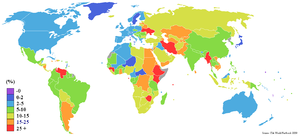
Image via Wikipedia
In my previous post about calculating returns, I briefly touched upon the notion of “risk adjusting” any projected returns to see if it makes sense compared to different investment options available. Today I’m going to discuss the biggest unavoidable risk of all: inflation.
Inflation is the erosion of value of money over time. i.e., as time progresses, the same Rupee buys less goods or services. We have all seen its effects first hand – I can’t think of single thing that has become cheaper over the years in India. So how does inflation affect investment decisions?
If you just took all your money and kept it in a vault, over a period of a year, you’ll get only 90% of it back. Where did the 10% go? Inflation took it (assuming a 10% annual inflation rate). Now imagine what happens if you socked away your money in a vault over a period of 10 years? How much will you get back then?
The rate of inflation plays a crucial role in calculating returns on investments. So important, in fact, that the way we calculated returns yesterday is called “nominal returns”. When you adjust nominal returns for inflation over the same period of time, you get “real returns.”
There are various measures of inflation depending on who it affects, but the most popular of them is the CPI – the Consumer Price Index. A good rule of thumb is to subtract nominal returns with the CPI to see how much you really end up making.
Different investments react differently to changes in inflation. For example, real assets, like real estate are supposed to be immune to inflation since their value is expected to rise along with it. Bonds perform poorly in an inflationary scenario because you get a fixed return. Stocks fall somewhere in between.
So its almost always a poor investment to keep cash in a vault. At the very least, your returns should at least match the rate of inflation.




